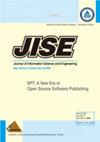Stepwise Adaptive Video Streaming in the Wireless Mobile Network Using the Temporal-Geo Bandwidth Estimation Method
IF 1.1
4区 计算机科学
Q4 COMPUTER SCIENCE, INFORMATION SYSTEMS
Journal of Information Science and Engineering
Pub Date : 2021-05-01
DOI:10.6688/JISE.20210537(3).0011
引用次数: 1
Abstract
With the advance of wireless mobile communication technologies, video streaming has advanced much more on these years. However, the wireless mobile network usually suffers fluctuation in available bandwidth because mobile users usually keep moving and playing streaming video simultaneously. To overcome the situation, this work proposed a method called Stepwise Adaptive Streaming using Temporal-Geo Bandwidth Estimation (SASTGBE) for the wireless mobile networking environment based on MPEG Dynamic Adaptive Streaming over HTTP (MPEG-DASH). To have better Quality Of Experience (QoE), e.g., no or fewer quality switching, lower bitrate difference between two continuous video segments, no or fewer suspended times, no or shorter paused time, etc., (1) the proposed method considers location, time, and date for estimating the available bandwidth in the future and (2) the proposed stepwise adaptive streaming control scheme considers buffer level, video quality of the most recently downloaded segment, the downloading rate of the most recently downloaded segment and the estimated bandwidth to decide the video quality for the next downloaded segment. The proposed method has been implemented in the Android system for the client side and the Linux system for the server side. The experiments using SASTGBE in the real environment shown that SASTGBE has improvement in the performance of bandwidth utilization, suspended times, quality switch percentage, average bitrate difference considering suspending, and standard deviation of bitrate difference over the wireless mobile network.基于时地带宽估计方法的无线移动网络逐步自适应视频流
随着无线移动通信技术的发展,视频流技术近年来有了很大的发展。然而,由于移动用户经常同时移动和播放流媒体视频,无线移动网络的可用带宽经常会出现波动。为了克服这种情况,本工作提出了一种基于MPEG动态自适应流over HTTP (MPEG- dash)的无线移动网络环境中使用时地带宽估计的逐步自适应流(SASTGBE)方法。为了获得更好的体验质量(QoE),例如,没有或更少的质量切换,两个连续视频片段之间的比特率差更小,没有或更少的暂停时间,没有或更短的暂停时间等,(1)提出的方法考虑位置,时间和日期来估计未来可用的带宽;(2)提出的逐步自适应流控制方案考虑缓冲级别,最近下载的视频片段的视频质量,最近下载段的下载速率和估计带宽,以决定下一个下载段的视频质量。该方法已在客户端为Android系统和服务器端为Linux系统上实现。在实际环境中使用SASTGBE的实验表明,SASTGBE在带宽利用率、挂起次数、质量切换率、考虑挂起的平均比特率差、比特率差的标准差等性能上都有提高。
本文章由计算机程序翻译,如有差异,请以英文原文为准。
求助全文
约1分钟内获得全文
求助全文
来源期刊

Journal of Information Science and Engineering
工程技术-计算机:信息系统
CiteScore
2.00
自引率
0.00%
发文量
4
审稿时长
8 months
期刊介绍:
The Journal of Information Science and Engineering is dedicated to the dissemination of information on computer science, computer engineering, and computer systems. This journal encourages articles on original research in the areas of computer hardware, software, man-machine interface, theory and applications. tutorial papers in the above-mentioned areas, and state-of-the-art papers on various aspects of computer systems and applications.
 求助内容:
求助内容: 应助结果提醒方式:
应助结果提醒方式:


